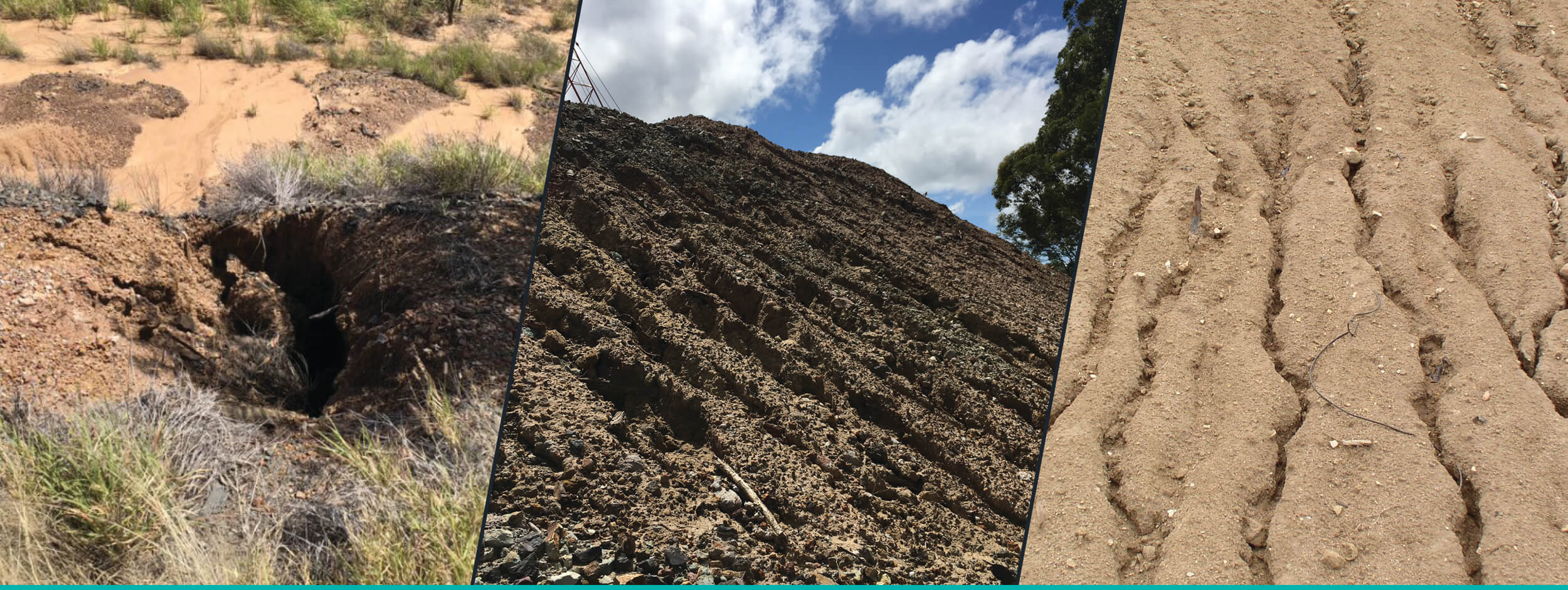Teck Talk 5: Do you understand dispersive and sodic soils and what they mean for your site?
Dispersive soils can be problematic for construction activities, and should be identified so their impacts can be addressed during planning. It is often a development condition that an approved dispersive soils management plan be established prior to commencement of operational works. The terms sodic and dispersive are frequently used interchangeably, however, not all dispersive soils are sodic and not all sodic soils are dispersive.
What are dispersive soils?
Dispersive soils occur when soil aggregates collapse as individual clay particles disperse into solution when the soil gets wet by fresh water. This collapse of the soil structure causes the soil to slump and lose porosity. Soil dispersion in the surface soil leads to crusting and surface sealing. Dispersion in the subsoil accelerates erosion and may lead to the formation of gullies and tunnels.
What are sodic soils?
Sodic soils are soils with an exchangeable sodium of greater than 6% of the total cation exchange capacity. When a sodic soil comes into contact with water, it may become unstable and ‘disperse’. Non-saline sodic soils are usually dispersive in the presence of fresh water. Saline-sodic clays are less dispersive than non-saline-sodic soils and have higher infiltration rates.
The problem
Several structural and biological problems can arise from dispersion of unstable soils. Development on sites where dispersive soils are present has the potential to increase the occurrence of infrastructure damage and environmental harm (e.g. adversely impacting water quality) as a result of tunnel and surface erosion.
Additionally, the disturbance of dispersive soils can negatively impact plant growth and revegetation success. The flow chart below summarises the impact of dispersive soil disturbance and some implications for construction activities.
Identifying dispersive soils
There are 3 main ways of identifying dispersive soils:
Field testing (indication only)
Dispersion test in water to identify occurrence and level of clay particle dispersion
Soils that feel slippery/soapy when wet can indicate sodic soils
Visual observations (indication only)
Tunnel and gully erosion
Deep incised rill erosion
Turbid milky water ponding on the soil surface
Bleached A2 soil horizon
Laboratory analysis
Exchangeable sodium potential (ESP). 6% sodium and greater indicates sodic soils
pH
Emerson Aggregate Test. Values greater than 6 indicate negligible dispersion. Value less than 6 indicate dispersive soil, with dispersibility being higher at lower Emerson values
Strong acidity, the presence of calcium and high salinity levels my inhibit dispersion
Management options
The repair of tunnel erosion is often difficult to achieve, is prone to re-failure and can be very expensive. As such, prevention of disturbance is typically the preferred management option for dispersive and sodic soils. Early identification of dispersive soils will allow management measures to be priced into tenders. Avoidance of the exposure and use of dispersive soils is preferred, however, if this is not viable or cost effective, several management options are available:
Capping with topsoil or burial below non-dispersive materials
Depth of topsoil is ideally related to climatic conditions (rainfall etc.), topsoil texture and structure and the demands of established vegetation
Managing water flows though ESC
Divert water away from dispersive materials
Limit the potential for ponding and convergence of surface water
Compact materials to limit water movement through soils
Chemical amelioration
Apply calcium products such as Gypsum to soils to reduce the sodium component within soils
Must be guided by laboratory test results
May need to be deep-ripped into the soil to treat sodic subsoils.
Summary
Dispersive and sodic soils can be problematic for construction activities, and should be identified early so the management of the soils can be incorporated into project planning. It is now often a development condition that an approved dispersive soils management plan be established prior to commencement of operational works.
The terms sodic and dispersive are frequently used interchangeably, however, not all dispersive soils are sodic and not all sodic soils are dispersive. Dispersive soils occur when soil aggregates collapse as individual clay particles disperse into solution when the soil gets wet by fresh water. Sodic soils are soils with an exchangeable sodium of greater than 6% of the total cation exchange capacity. When a sodic soil comes into contact with water, it may become unstable and ‘disperse’.
If possible and financially viable, dispersive soils should be avoided during construction, as they are prone to tunnel and rill erosion and depletion of soil structure. This can result in reduced revegetation success, difficulties in managing site erosion and sediment control, environmental harm and potential infrastructure damage, ultimately leading to increased costs.
However, if avoidance is not possible during planning, several management options are available to minimise the impacts and costs of dispersive soils during construction. If your team needs assistance with dispersive soil management, Topo have experience in this area and can be of assistance.


